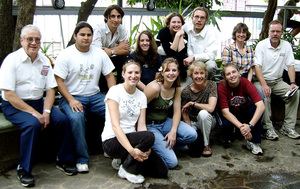CSC group visits Costa Rica, 'where the action is'

During the recent holiday break, two Chadron State College faculty members and 10 students went “where the action is,” in the words of one of the professors, Dr. Ron Weedon.
The group spent nearly a week in Costa Rica, the Central American nation that has become a Mecca for scientific exploration. Weedon said more species of plants can be seen in an acre of tropical rain forest in Costa Rica than are in all of Nebraska. His faculty cohort on the trip, Dr. Mike Leite, added that every geoscientist such as himself should see an active volcano, and Costa Rica has about a dozen of them.
“There’s so much biomass there,” said Weedon. “It’s one thing to see it on the Discovery Channel and another thing to see it yourself. It’s also a nice, safe place to visit. It’s a friendly, positive nation and for the most part they like Americans. Because of groups like ours, tourism is a major industry.”
Weedon and Leite have been planning the trip for a couple of years. In the summer of 2004, they spent nearly nine days in the country as participants in a National Science Foundation Chautauqua in Costa Rico. Afterwards, they knew they wanted to return and would take students with them.
Each of the students had a study project ranging from art and learning the Spanish language to studying orchids (there are 32,000 varieties of them in Costa Rica), butterflies, the grasslands and rocks and minerals.
For the biologists and botanists who study under Weedon at CSC, the tropical rain forest was the attraction. While much of Costa Rica’s dense jungle areas have been destroyed to make way for cattle ranching through the years, the country has been making a concerted effort in recent years to preserve much of what’s remaining and to restore other areas.
“The government has committed 10 percent of the land to national parks that will preserve the tropical rain forests,” said Weedon. “Many charitable organizations are contributing to effort.”
According to the trip participants, the importance of such action can’t be overstated, particularly in view of recent weather patterns that indicate global warming is kicking in throughout the world.
A quote from E.O. Wilson, preeminent ecologist from Harvard on a huge poster that Leite developed following the trip states, “Destroying rainforest for economic gain is like burning a Renaissance painting to cook a meal.”
“So much of our global climate is fueled by the tropics,” said Weedon. “Plants absorb carbon dioxide and that slows global warming. We’ve all got to be thankful for what Costa Rica is doing. We need other countries, including our own, to follow suit.”
Four full days, or about half the trip, were spent at the LaSelva Biological Station that is designed to host scientific visitors such as the CSC group and others who stay for extended periods.
One of the CSC students on the trip, Leslie Stewart-Phelps of Crawford, used the restoration of the rainforest as her project for the trip. She said the LeSelva station, which encompasses at least 1,000 acres, includes both old growth rain forest and areas that are being restored.
“It (the station) is so rich in plants, insects, birds and small animals such as monkeys,” she said. “Both the facilities and the people there are great, too. It’s a wonderful place to visit and learn.”
The Arenal Volcano is the major attraction to geoscientists such as Leite. He and the others on the trip viewed it from about 1 ½ miles away.
“It’s pretty impressive to hear and see (particularly at night) rocks the size of a house tumbling down the mountain,” said Leite. “It gets to your soul.”
He said the volcanoes, which can be extremely dangerous when a full eruption occurs, also help maintain the fertility of the soil. He said Costa Rica is “incredibly productive” because the volcanic ash periodically replaces nutrients that are washed out of the soil by the high rainfall.
Leite also was impressed by the plethora of plants and animals in Costa Rica and the steps being take to preserve them.
“The country has learned that the forest itself is a resource that has economic value attached to it. All in all, it was an incredible trip.”
Both professors hope to lead similar excursions at least every other year. The trip was made easier by the Organization of Tropical Studies, which does the trip logistics and handles the transportation needs.
Weedon and a couple of his students didn’t return from Costa Rica empty-handed they brought back numerous seeds that they are attempting to grow in the college’s greenhouse. In addition, he harvested some plants, mostly from along roadsides, to add to the Chadron State herbarium.
Weedon added that many of the tropical plants that grace American homes and businesses come from Costa Rica.
Students on the trip besides Phelps-Stewart were Andrew Cassiday of Chadron, Franklin Gilmore-Metz of Crawford, Megan Morrill of Rushville, Paul Nelson of Northeast Harbor, Maine; Sara Placke of St. Libory, Neb., Pam Row of Chappell, Elisabeth Saunders of Gillette, Wyo., and Nancy Sharps and Rena Tucker of Chadron.
Category: Campus News
